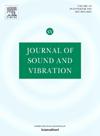Vibration characteristic analysis of a two-stage spur gear transmission system with tooth crack and profile shifted
IF 4.3
2区 工程技术
Q1 ACOUSTICS
引用次数: 0
Abstract
Gear transmission systems in engineering often involve multiple stages, making vibration and fault analysis critical. This study introduces a revised spur gear time-varying mesh stiffness(TVMS) model using the potential energy method, incorporating nonlinear Hertzian contact stiffness and the coupling effects of healthy and cracked gear fillet-foundation stiffness, along with profile shift coefficients. The analysis shows that cracked gears introduce rotational frequency components into the mesh stiffness spectrum, while the profile shift coefficient influences the amplitude of mesh frequencies and their harmonics. A finite element model of a two-stage spur gear system, incorporating tooth cracks and profile shift coefficients, is developed to analyze the vibration response characteristics of healthy systems, systems with varying profile shift coefficients, and systems with different crack depths. The results indicate that in the frequency domain, a healthy two-stage spur gear transmission system exhibits not only the mesh frequencies and their harmonics but also a rich combination of these frequencies. The fault frequency for cracked gear systems corresponds to the rotational frequency of the cracked shaft and its modulation with two-stage mesh frequencies. Frequency sweeping analysis shows that varying installation positions change natural frequencies and their corresponding amplitude-frequency response, providing strategies to avoid resonance with operational speeds. In amplitude-frequency characteristics, crack depth notably impacts the amplitude at non-resonant peaks, whereas the profile shift coefficient affects the amplitude at resonant peaks. The time-domain statistical indicators(RMS, kurtosis, and IE) do not consistently respond to variations in crack depth across the entire frequency range under consideration; among these indicators, the kurtosis of the displacement signal emerges as the optimal indicator for detecting gear cracks. These findings offer valuable insights for the design and fault diagnosis of two-stage spur gear transmission systems.
带齿裂和齿形移位的两级直齿轮传动系统振动特性分析
工程中的齿轮传动系统通常涉及多个阶段,因此振动和故障分析至关重要。该研究采用势能法引入了一种修正的直齿轮时变啮合刚度(TVMS)模型,该模型考虑了非线性赫兹接触刚度、健康齿轮和裂纹齿轮圆角-基础刚度的耦合效应以及齿形位移系数。分析表明,齿轮裂纹在啮合刚度谱中引入了转动频率分量,而齿廓位移系数影响啮合频率幅值及其谐波。建立了考虑齿隙和齿形位移系数的两级直齿轮系统有限元模型,分析了健康系统、不同齿形位移系数系统和不同裂纹深度系统的振动响应特性。结果表明,在频域上,一个健康的两级直齿齿轮传动系统不仅具有啮合频率及其谐波,而且具有这些频率的丰富组合。裂纹齿轮系统的故障频率对应于裂纹轴的旋转频率及其两级啮合频率调制。频扫分析表明,不同的安装位置会改变固有频率及其相应的幅频响应,从而提供避免与运行速度共振的策略。在幅频特性中,裂纹深度对非共振峰幅值有显著影响,而剖面位移系数对共振峰幅值有显著影响。时域统计指标(均方根、峰度和IE)在考虑的整个频率范围内对裂纹深度的变化没有一致的响应;在这些指标中,位移信号的峰度是检测齿轮裂纹的最佳指标。这些发现为两级直齿轮传动系统的设计和故障诊断提供了有价值的见解。
本文章由计算机程序翻译,如有差异,请以英文原文为准。
求助全文
约1分钟内获得全文
求助全文
来源期刊

Journal of Sound and Vibration
工程技术-工程:机械
CiteScore
9.10
自引率
10.60%
发文量
551
审稿时长
69 days
期刊介绍:
The Journal of Sound and Vibration (JSV) is an independent journal devoted to the prompt publication of original papers, both theoretical and experimental, that provide new information on any aspect of sound or vibration. There is an emphasis on fundamental work that has potential for practical application.
JSV was founded and operates on the premise that the subject of sound and vibration requires a journal that publishes papers of a high technical standard across the various subdisciplines, thus facilitating awareness of techniques and discoveries in one area that may be applicable in others.
 求助内容:
求助内容: 应助结果提醒方式:
应助结果提醒方式:


